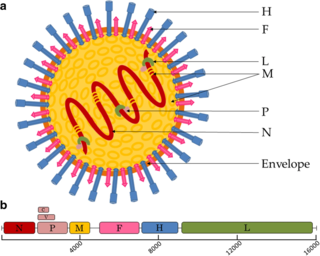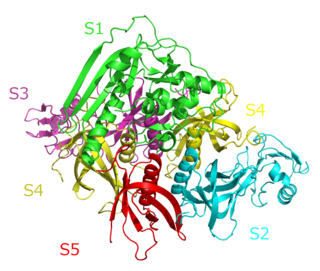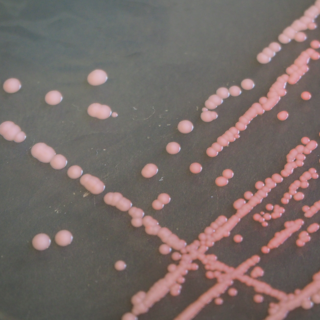
Paramyxoviridae is a family of negative-strand RNA viruses in the order Mononegavirales. Vertebrates serve as natural hosts. Diseases associated with this family include measles, mumps, and respiratory tract infections. The family has four subfamilies, 17 genera, and 78 species, three genera of which are unassigned to a subfamily.

Bordetella bronchiseptica is a small, gram-negative, rod-shaped bacterium of the genus Bordetella. It can cause infectious bronchitis in dogs and other animals, but rarely infects humans. Closely related to B. pertussis—the obligate human pathogen that causes pertussis ; B. bronchiseptica can persist in the environment for extended periods.

Haemophilus influenzae is a Gram-negative, coccobacillary, facultatively anaerobic capnophilic pathogenic bacterium of the family Pasteurellaceae. H. influenzae was first described in 1892 by Richard Pfeiffer during an influenza pandemic. He incorrectly described Haemophilus influenzae as the causative microbe, which retains "influenza" in its name.

Bordetella is a genus of small, gram-negative coccobacilli of the phylum Proteobacteria. Bordetella species, with the exception of B. petrii, are obligate aerobes, as well as highly fastidious, or difficult to culture. All species can infect humans. The first three species to be described ; are sometimes referred to as the 'classical species'. Two of these are also motile.

Pertussis toxin (PT) is a protein-based AB5-type exotoxin produced by the bacterium Bordetella pertussis, which causes whooping cough. PT is involved in the colonization of the respiratory tract and the establishment of infection. Research suggests PT may have a therapeutic role in treating a number of common human ailments, including hypertension, viral infection, and autoimmunity.

Bordetella pertussis is a Gram-negative, aerobic, pathogenic, encapsulated coccobacillus of the genus Bordetella, and the causative agent of pertussis or whooping cough. Like B. bronchiseptica, B. pertussis is motile and expresses a flagellum-like structure. Its virulence factors include pertussis toxin, adenylate cyclase toxin, filamentous hæmagglutinin, pertactin, fimbria, and tracheal cytotoxin.

Pasteurella multocida is a Gram-negative, nonmotile, penicillin-sensitive coccobacillus of the family Pasteurellaceae. Strains of the species are currently classified into five serogroups based on capsular composition and 16 somatic serovars (1–16). P. multocida is the cause of a range of diseases in mammals and birds, including fowl cholera in poultry, atrophic rhinitis in pigs, and bovine hemorrhagic septicemia in cattle and buffalo. It can also cause a zoonotic infection in humans, which typically is a result of bites or scratches from domestic pets. Many mammals and birds harbor it as part of their normal respiratory microbiota.

Bordetella parapertussis is a small Gram-negative bacterium of the genus Bordetella that is adapted to colonise the mammalian respiratory tract. Pertussis caused by B. parapertussis manifests with similar symptoms to B. pertussis-derived disease, but in general tends to be less severe. Immunity derived from B. pertussis does not protect against infection by B. parapertussis, however, because the O-antigen is found only on B. parapertussis. This antigen protects B. parapertussis against antibodies specific to B. pertussis, so the bacteria are free to colonize the host's lungs without being subject to attack by previous antibodies. These findings suggest B. parapertussis evolved in a host population that had already developed immunity to B. pertussis, where being able to evade B. pertussis immunity was an advantage.
Mycobacterium elephantis, a bacterium of the family Mycobacteriaceae, was discovered and isolated from a deceased elephant near India and may be linked to respiratory dysfunction. Organisms in the genus Mycobacterium are known to be aerobic and non-motile. Organisms within Mycobacterium belong to either the rapid growing group or the slow growing group. M. elephantis is classified as a rapid grower and relates most closely to Mycobacterium confluentis and Mycobacterium phlei.
Streptococcus zooepidemicus is a Lancefield group C streptococcus that was first isolated in 1934 by P. R. Edwards, and named Animal pyogens A. It's a mucosal commensal and opportunistic pathogen that infects several animals and humans, but most commonly isolated from the uterus of mares. It's a subspecies of Streptococcus equi, a contagious upper respiratory tract infection of horses, and shares greater than 98% DNA homology, as well as many of the same virulence factors.

Streptobacillus moniliformis is a non-motile, Gram-negative rod-shaped bacterium that is a member of the family Leptotrichiaceae. The genome of S. moniliformis is one of two completed sequences of the order Fusobacteriales. Its name comes from the Greek word streptos for "curved" or "twisted", and the Latin words bacillus meaning "small rod" and moniliformis for "necklace". S. moniliformis is microaerophilic, requiring less oxygen than is present in the atmosphere for its growth.
Neisseria bacilliformis is a bacterium commonly found living as a commensal in the mucous membranes of mammals. However, depending on host immunocompetence, there have been documented cases of N. bacilliformis infections of the respiratory tract and oral cavity thus making it an opportunistic pathogen. It was originally isolated from patients being treated in a cancer center. Rarely, a more serious infection such as endocarditis can occur often as a result of a predisposing condition.
Bordetella holmesii is a Gram-negative, rod-shaped bacterium of the genus Bordetella. It was named in recognition of Barry Holmes, a biologist. It is asaccharolytic, oxidase-negative, and nonmotile, producing a brown pigment. It is associated with sepsis, endocarditis, and respiratory illness, especially in immunocompromised patients, such as asplenic or AIDS patients. It is often seen in conjunction with Bordetella pertussis infections, although not always.

Achromobacter xylosoxidans is a Gram-negative, aerobic, oxidase and catalase-positive, motile bacterium with peritrichous flagella, from the genus Achromobacter. It is generally found in wet environments. Achromobacter xylosoxidans can cause infections such as bacteremia, especially in patients with cystic fibrosis. In 2013, the complete genome of an A. xylosoxidans strain from a patient with cystic fibrosis was sequenced.
Legionella cherrii is an aerobic, flagellated, Gram-negative bacterium from the genus Legionella. It was isolated from a heated water sample in Minnesota. L. cherrii is similar to another Legionella species, L. pneumophila, and is believed to cause major respiratory problems.
Legionella jordanis is a Gram-negative bacterium from the genus Legionella which was isolated from the Jordan River in Bloomington, Indiana and from the sewage in DeKalb County, Georgia. L. jordanis is a rare human pathogen and can cause respiratory tract infections.
Flavobacterium psychrophilum is a psychrophilic, gram-negative bacterial rod, belonging to the Bacteriodetes. It is the causative agent of bacterial coldwater disease (BCWD) and was first isolated in 1948 during a die-off in the salmonid Oncorhychus kisutch.
Crenobacter cavernea Cave-375 is a gram negative bacterium that is closely related to a previously discovered Crenobacter cavernae strain K1W11S-77ͭ. C. cavernea Cave-375 has not directly been described morphologically, however the related strain K1W11S-77ͭ is a "rod-shaped, motile, and strictly aerobic novel bacteria".
Rhodoplanes azumiensis is a thermotolerant Proteobacteria isolated from sediment mud and cyanobacterial mats located in Nakanoyu hot springs, located in the Azumi district, Matsumoto, Nagano Prefecture, Japan. R. azumiensis is a photoheterotroph that is capable of using many organic materials as its carbon source. Colonies and liquid cultures exhibit a brownish red color when grown phototrophically, and are colorless when grown aerobically in darkness.

Arthrobacter bussei is a pink-coloured, aerobic, coccus-shaped, Gram-stain-positive, oxidase-positive and catalase-positive bacterium isolated from cheese made of cow´s milk. A. bussei is non-motile and does not form spores. Rod–coccus life cycle is not observed. Cells are 1.1–1.5 µm in diameter. On trypticase soy agar it forms pink-coloured, raised and round colonies, which are 1.0 mm in diameter after 5 days at 30 °C The genome of the strain A. bussei KR32T has been fully sequenced.










